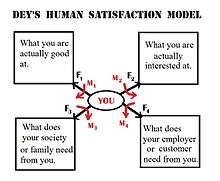
Dey's human satisfaction model is conceptualized and introduced by Sudip Dey (2016) in conjunction to Job Satisfaction. It is a mathematical model in order to quantify the level of human satisfaction. Job satisfaction is often difficult to quantify as it is linked with many attributes of human satisfaction. Dey's human satisfaction model illustrates the methodology for quantification of human satisfaction which is broadly coupled with four major factors. By and large, all human being are driven by these major four factors, namely,
1) What you are actually good at (i.e., based on your core-competency and your acquired or natural skills)
2) What you are interested at (based on your areas of interest by self-motivation)
3) What does your society need (based on your societal and to some extent, your family needs)
4) What does your employer/customer need from you (based on your employer's or customer's needs).
There are always unbalanced forces and moments acting on "YOU" which result in your degree of "SATISFACTION". The tug of war among all these unbalanced forces and moments are intrusively random function in the domain of space and time. The only condition to yield 100% efficiency at your level of satisfaction occurs when all these forces and moments are equal and opposite in direction. In reality, it is a continuous challenge which you are facing and dealing with every day, every moment. The solution for stability is "convergence" and "balancing" of all these forces and moments.
Quotes
- The higher we go, the ups and downs at the lower level would gradually fade. If what we do is to be worth while and if we are to get job satisfaction, we have to study more and work hard. The more we work, the stronger the profession would become and grow.
- D. V. Gundappa (2002), Sahitya Akademi, p. 19
- There is a great variety of measures of job attitudes. Basically, however, the identification of job attitudes has been done in three ways. In the first of these the worker is asked to express his "job satisfaction" directly by answering questions that investigate his over-all attitude toward his job, whether he likes or dislikes it.
- Frederick Herzberg, Bernard Mausner and Barbara B. Snyderman, (1959) The motivation to work, New York: John Wiley & Sons. p. 5
- Job satisfaction and job dissatisfaction are not the obverse of each other... The opposite of job satisfaction would not be job dissatisfaction, but rather would be no job satisfaction. Similarly, the opposite of job dissatisfaction is no job dissatisfaction, not satisfaction with one's job.
- Frederick Herzberg (1966). Work and the nature of man. Cleveland, OH: World Publishing. p. 76
- I can charge a man's battery, and then recharge it, and recharge it again. But it is only when he has his own generator that we can talk about motivation. He then needs no outside stimulation. He wants to do it.
- Frederick Herzberg, in: M.M. Gruneberg (1976), Job Satisfaction. p. 19
- Job satisfaction is, without a doubt, one of the most heavily studied topics in organizational psychology, as well as in the broader field of industrial/organizational psychology. To emphasize this point, many authors, over the years, have referred to Locke’s chapter in the Handbook of Industrial and Organizational Psychology (1976), where he reported that studies dealing with job satisfaction numbered in the thousands.
- Steve M. Jex, Thomas W. Britt (2002). Organizational Psychology: A Scientist-Practitioner Approach. John Wiley & Sons; 2nd ed. 2008. p. 116
- Job satisfaction is typically defined as an employee’s level of positive affect toward his or her job or job situation... Along with positive affect, we can add both a cognitive and a behavioral component to this definition... The cognitive aspect of job satisfaction represents an employee’s beliefs about his or her job or job situation; that is, an employee may believe that his or her job is interesting, stimulating, dull, or demanding—to name a few options... The behavioral component represents an employee’s behaviors or, more often, behavioral tendencies toward his or her job. An employee’s level of job satisfaction may be revealed by the fact that he or she tries to attend work regularly, works hard, and intends to remain a member of the organization for a long period of time.
- Steve M. Jex, Thomas W. Britt (2002). Organizational Psychology: A Scientist-Practitioner Approach. John Wiley & Sons; 2nd ed. 2008. p. 116
- Hackett and Guion (1985) offer a number of explanations for the weak relation between job satisfaction and absenteeism. One reason is the measurement of absenteeism itself. Although at first glance absenteeism would appear to be a rather simple variable, it is actually quite complex. For example, when measuring absences, one can distinguish between excused and unexcused absences. Excused absences would be allowed for events such as illnesses and funerals. In unexcused absences, the employee simply does not show up at work. One could argue that job satisfaction would be more likely to play a role in unexcused than in excused absences.
- Steve M. Jex, Thomas W. Britt (2002). Organizational Psychology: A Scientist-Practitioner Approach. John Wiley & Sons; 2nd ed. 2008. p. 126